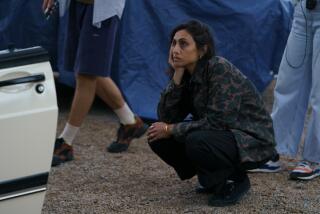At the time it seemed like a good number
- Share via
WHETHER he meant it as a threat or a promise, French filmmaker Luc Besson had long ago predicted that he would stop directing after finishing 10 films.
Having made a name for himself internationally by bringing the flair and panache of a European fashion shoot to American-style action movies with such films as “La Femme Nikita” and “The Professional,” Besson has more recently refashioned himself as a mogul, writing, producing and distributing an astonishing number of films in France. Yet sticking to only 10 films as director would allow him to do everything he set out to achieve as a filmmaker without repeating himself.
“After 30 years you don’t have the same energy, you have the feeling you’ve expressed yourself a lot, you don’t want to say the same thing over and over, you want to bring something new or fresh and you want to surprise the people,” said Besson, 48. “And you’re not sure you can, after 10 films. I really have the feeling it’s a kind of loop, I’ve done something, and it’s done.”
Well, Besson has finally hit his magic number.
A film of lyrical whimsy and freewheeling humor, “Angel-A” -- which opened Friday in Los Angeles -- is both a fitting summation to Besson’s directing career and also something of a postcard valentine to Paris.
Shot in beautiful, deep-focus black and white by Besson’s longtime cinematographer, Thierry Arbogast, it is no accident that throughout the film the Eiffel Tower continually pops up in the background of the frame, like a spindle on which the action rotates.
In the film, a small-time hoodlum (played by popular French comedian Jamel Debbouze), down on his luck, stands on one of Paris’ famous bridges contemplating suicide when he notices a beautiful woman (former Victoria’s Secret model Rie Rasmussen) doing the same. After he saves her, the two begin their own knockabout adventure through an underworld of nightclubs, cafes and gamblers’ hangouts until she reveals her true self to him.
“I wrote the film a long time ago and put it aside,” Besson said. “I couldn’t finish it. Then I met Rie, and I met Jamel, and it’s like a little light went off in my head, ‘Oh, this girl with this guy, that could be good.’ ”
If one would assume Besson to be a blustery showman, like a cross between Quentin Tarantino and Harvey Weinstein -- the mind reels -- he actually comes across as unassuming and remarkably shy. He arrived for a recent lunchtime interview with Rasmussen in tow. (They have been promoting the film together for nearly two years -- the U.S. is the last territory left to open.) Shot in summer 2005, some of the film was made on conventional soundstages, though quite a bit of it was shot in the streets of Paris. At times, Besson would shoot without permits, just jumping out of a van with a skeleton crew and his actors, while other times he would use massive cranes and equipment and official permission.
To avoid being noticed, they would misidentify their equipment trucks as being from a production called “The Beauty of the Seine” -- which would not be an altogether inaccurate title for the film -- but Besson also often used a visiting Hollywood production to avoid onlookers.
“Jamel and me,” he said, “we’re quite popular in France. So it’s always difficult to shoot.... One of the tricks we had was to give out the address of where ‘The Da Vinci Code’ was shooting, so all the paparazzi and journalists went there.”
“Angel-A” began during an impasse in the production of “Arthur and the Invisibles,” based on Besson’s own series of children’s books. An ambitious blend of animation and live-action, “Arthur” required long and tedious computer work.
“Animation is great,” Besson said of the project, “but it’s like 500 people with a mouse and computers.... It’s so slow.
“I think ‘Angel-A’ came from frustration with the long process of ‘Arthur.’ ”
Whether he intends to willfully contradict himself or not, Besson mentions his plan to direct two “Arthur” sequels, which he sees as merely a continuation of the same project.
But then, he thinks, that’s it.
Really.
Maybe.
More to Read
Only good movies
Get the Indie Focus newsletter, Mark Olsen's weekly guide to the world of cinema.
You may occasionally receive promotional content from the Los Angeles Times.











